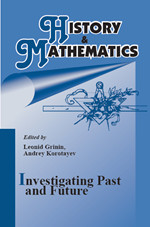
|
History & Mathematics:Investigating Past and FutureBibliography: Volgograd: ‘Uchitel’ Publishing House, 2020. – 248 pp.
Edited by: Edited by Leonid E. Grinin, and Andrey V. Korotayev
ISBN 978-5-7057-5464-9 Editorial Council: Herbert Barry III (Pittsburgh University), Leonid Borodkin (Moscow State University; Cliometric Society), Robert Carneiro (American Museum of Natural History), Christopher Chase-Dunn (University of California, Riverside), Tessaleno Devezas (University of Beira Interior), Jack A. Goldstone (George Mason University), Leonid Grinin (National Research University Higher School of Economics), Antony Harper (Eurasian Center for Big History & System Forecasting), Peter Herrmann (University College of Cork, Ireland), Andrey Korotayev (Higher School of Economics), Alexander Logunov (Russian State University for the Humanities), Georgy Malinetsky (Russian Academy of Sciences), Sergey Malkov (Russian Academy of Sciences), Charles Spencer (American Museum of Natural History), Rein Taagepera (University of California, Irvine), Arno Tausch (Innsbruck University), William Thompson (University of Indiana), Peter Turchin (University of Connecticut), Douglas White (University of California, Irvine), Yasuhide Yamanouchi (University of Tokyo).
|
The present Yearbook (which is the eighth in the series) is subtitled Investigating Past and Future. It is devoted to three problems: the analysis of the aspects of past and present in the light of formal methods; singularity, i.e. forthcoming abrupt shift in development, the approach (or even presence) of which we already feel; the aspects of the cosmic future of human race.
This issue consists of four sections: (I) History, Technologies, Politics, and Mathematics includes five articles on different directions of factual or theoretical content: history, technology, politics, and studies covering past, present, and future; (II) Singularity includes two contributions and is devoted to a rather interesting phenomenon of singularity. They suggest that indeed the hyperbolic planetary evolutionary trend observed since the origins of life on the Earth cannot continue beyond the forthcoming singularity, whereas the post-singular evolutionary trend should be qualitatively different from what has been observed before; (III) Beyond the Earth also consists of two very different articles, but they are united by their interest in the future of human race in terms of their interaction with the space; (IV) Reviews and Notes.
We hope that this issue will be interesting and useful both for historians and mathematicians, as well as for all those dealing with various social and natural sciences.